Three-way valve in heating systems and floor heating systems
In this article we will consider the features of the valves. In particular, their principle of operation: a three-way valve, for example, has distinctive features, in accordance with which it functions. In addition, we will talk about the structural and operational features of these devices and about where and how they can be applied.
The topic of the article is of particular interest, since the device of medium and large in length heating systems is associated with such a disadvantage as uneven distribution of heat. The reason for this problem is that the coolant is gradually cooled as it passes through the pipeline, and therefore its temperature will be higher near the heating unit than at the most distant point of the pipeline.
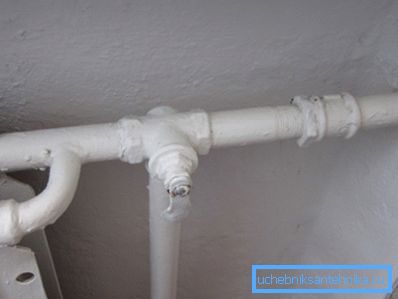
The solution to this problem is to build systems that use a three-way crane.
Application features
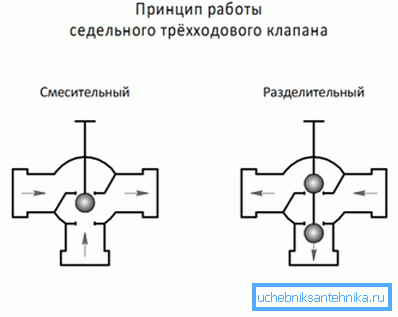
As already mentioned, the appointment of a three-way valve for the most part extends to the construction of heating pipelines of medium and large length, as well as for a warm floor with medium and large areas (see also the article Three-way valve for a pressure gauge: the purpose of the application, options for installation and maintenance ).
This type of valves does not simply regulate the pressure of the water, but allows you to immediately adjust the cold and hot flows. As a result of correct installation and proper operation of the device, it becomes possible to achieve a more efficient redistribution of the coolant in a closed system.
Important: In accordance with the requirements of GOST 21345-2005, stop valves of this type, in addition to building heating systems, can be used for installation on pipelines with a small diameter for subsequent transportation of gaseous, as well as corrosive and neutral liquid media.
Construction features
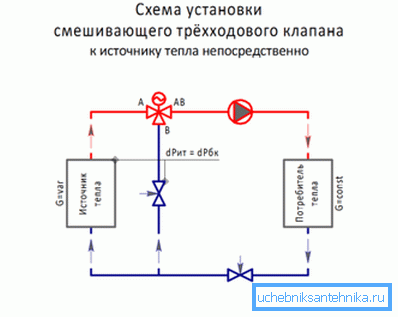
Structurally, the three-way valves are a tee equipped with a locking or regulating mechanism.
The design of the device includes such elements as:
- body, which can be made of brass, stainless steel, cast iron, etc .;
- gate this or that configuration with through openings
- nozzles.
The operation of the device is carried out by rotating around its axis of the flywheel attached to the gate stem. The adjusting lever can be rotated 90 or 180 degrees in order to open one or more through holes.
The extreme positions of the flywheel are designed to allow the fluid to pass through either one or the other. If the flywheel is turned to the neutral position, the water passes through two holes at once and the device functions as a mixer.
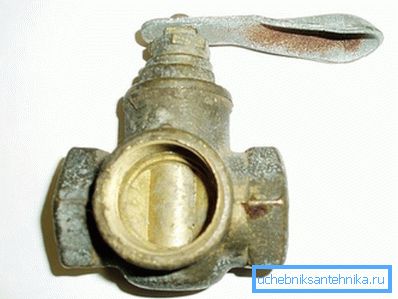
Important: Industrial modifications of the three-way valve, intended for the device of the pipeline through which the transport of flammable or explosive atmospheres is carried out, have special limiters of the extreme position of the flywheel. Modifications of locking equipment intended for use in household systems may not have such limiters.
Classification of valves of three-way type
Three-way valve or its larger industrial counterparts, the price of which is higher, is divided into several categories based on the following distinguishing characteristics:
- In accordance with the shape of the bolt, conical, ball and cylindrical modifications differ;
- In accordance with the type of flow-through part, designs with full bore or test and discharge housing are distinguished.
Modifications through passage are equipped with two connecting pipes intended for connection to the pipeline.
Devices of trial and release type, first of all, are intended for installation in various units and capacities. For ease of installation and subsequent operation, the complete set of the device includes the trigger and connecting pipe.
- In accordance with the configuration of the rotary element L-shaped, T-shaped and S-shaped taps are distinguished.

- In accordance with the installation method of the bolt mechanism, tension, gland and cork modifications are distinguished. In tension-type cranes, the stopper, when closed, is adjacent to the body directly with a nut. At the same time, the stuffing valve cork is adjacent to the body with the gland lid and packing gasket.
- Industrial three-way cranes are divided into devices with a heated case or with a case without heating.
- In accordance with the type of the connecting device, modifications of the flange, coupling, tsapkovy, choke-butt, welding type are distinguished.
- In accordance with the type of control there are different versions with manual and mechanized, pneumatic, hydraulic and electric drives.
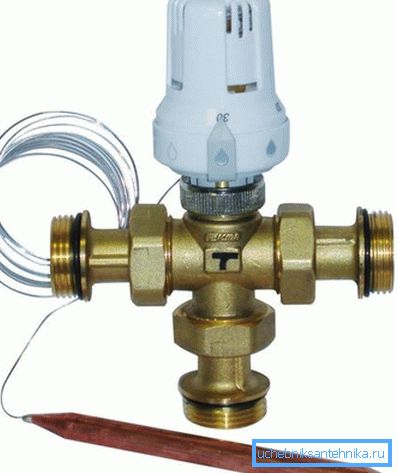
Regardless of belonging to one category or another, all three-way cranes are characterized by the absence of stagnant zones, durability, increased tightness of the locking element, a small degree of hydraulic resistance and simplicity of design.
But at the same time, such devices have some drawbacks, among them high torque, an increased probability of jamming of turning parts as a result of sticking in the process of long-term operation.
Requirements for installation and operation

- Three-way valves can be installed either horizontally or vertically.
- When carrying out installation works with your own hands, you must make sure that the direction of flow of the transported medium coincides with the arrow indicating the direction on the body of the device.
- The installation location of the crane must be selected in such a way that during subsequent operation and maintenance, there will be no problems with access to the valve or other regulatory equipment.
- In the case of installation with the use of welding equipment, care must be taken to protect the internal cavity of the faucets from falling inside the welded scale and grates. Again, it is necessary to prevent the case from heating up, the pipes of the pipelines joining more than + 100 ° C.
- Installation and subsequent operation of a three-way crane should be carried out in accordance with the requirements given in the accompanying documentation drawn up by the manufacturer.
- The use of valves requires the use of regular maintenance to prevent the valve from seizing.
Conclusion
Now we have a general idea of what a normal or specialized three-way hydraulic crane is. Still have questions about choosing the right equipment?
You can simplify the task by watching the video in this article.